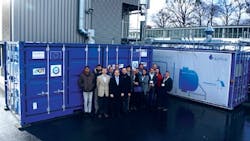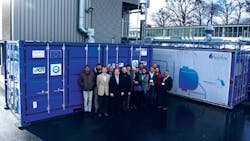P2G Process Marks Major Milestone
Researchers working on a project funded by the European Union have achieved an efficiency exceeding 75% for a power-to-gas (P2G) process. The Helmeth (integrated high-temperature electrolysis and methanation for effective power to gas conversion) project aims to develop a complete P2G module consisting of a pressurized steam electrolyzer module that is thermally integrated with an optimized carbon dioxide methanation module. A team at the Energy Center of the Karlsruhe Institute of Technology (KIT), Karlsruhe, Germany, is coordinating the €3.8-million ($4.7-million) effort.
The researchers are optimizing the process by using the heat generated during methanation to drive the high-pressure, high-temperature (800°C) electrolysis step.
During electrolysis, water initially splits into oxygen and hydrogen. Hydrogen then reacts with either carbon dioxide or carbon monoxide to produce methane, releasing heat. The methane is of high enough quality to go directly into the German natural gas network.
Figure 1. Demonstration facility combines methanation (left container) and electrolysis (right container) with an efficiency of 76%. Source: Sunfire.
The scientists hope the process will exceed 80% efficiency in industrial operation —if they can overcome some technical hurdles.
“The main challenge currently is mass flow of steam from methanation to the high-temperature electrolysis cell. The robustness needed isn’t there yet and so the total flow is very small,” says Manuel Gruber, KIT’s chair of combustion technology. Solving this could be a finicky job involving a number of fairly time-consuming steps, he notes. “However, a conversion rate of 90% would be possible when this is stabilized,” he believes.
Two other challenges are heat-related. The first involves heat losses from the cell at higher pressures; such pressures cause the insulation materials used to become more heat conductive. The second relates to the current heat exchanger. This is a relatively minor issue overall, explains Gruber, and one that could be solved by using a more efficient — but expensive — replacement.
At the moment, the process operates out of two 6-m-long sea containers, one housing the methanation module, the other the electrolysis module (Figure 1). “They are cheap, waterproof and can easily transport our test rigs. However, for the future, we are looking to a bigger-scale prototype that can be operated under a number of different operational environments,” he adds.
Gruber thinks the two industrial partners already involved in the project — Sunfire, Dresden, Germany, a specialist manufacturer of steam electrolysis modules, and electricity generating company Ethos Energy Italia, Turin, Italy — could provide the impetus for such scaled-up development.

